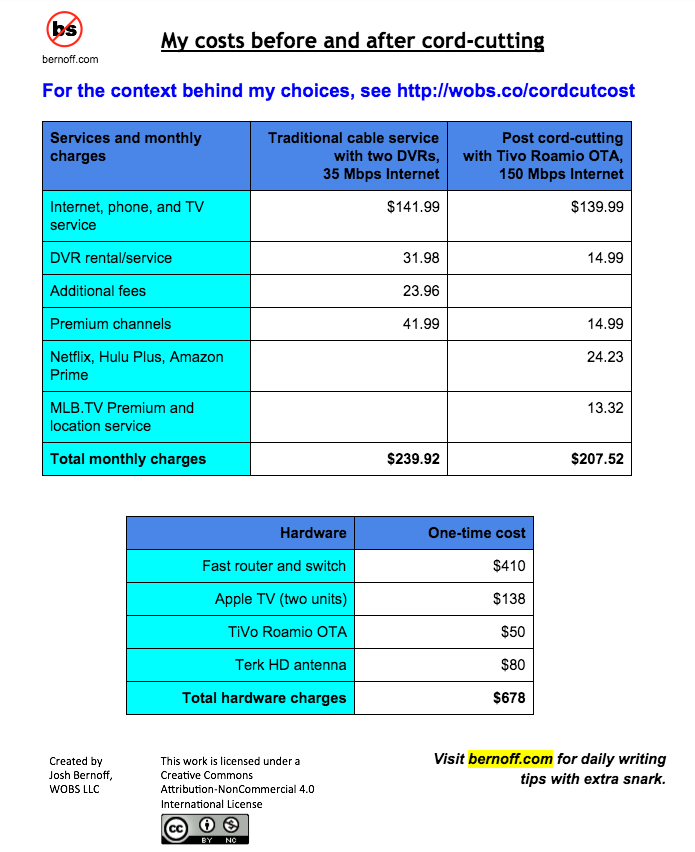The economics of cord-cutting at my house
When I cut the cable cord, I did it to get more of what I wanted (speed), not to save money. The economics are reasonable, but the benefits are a lot better.
My earlier post that described how I cut the cable cord was far more popular than I expected. Several of you asked about the actual costs. Now I’ll go through the numbers with you and share some of what I learned.
As you read this, keep two things in mind.
- Everyone’s decisions are different. If you’ve done this already, or if you plan to, you’ll inevitably do it differently from me. Cord-cutting is about choices. I hope you can learn from mine. (In other words, I’m not seeking advice on what I should have done.)
- My goal was to get more of what matters to me for about the same cost. My goal was not to save money. At the end of this post I’ll describe how you can save more money than I did.
OK, here’s a chart of my costs before and after. In the monthly costs, the first column is from my actual Verizon bill for previous months, and the second is from a helpful email they sent showing what my new bill will be. The second chart shows what I laid out for one-time costs for hardware.
I’m saving $22.40 a month. And my capital outlay was $678. So I’ll break even in 30 months. And this is the completely wrong way to look at things. Remember, I didn’t do this to save money, I did it get more of what I want.
Here’s what I got:
- Much faster Internet. This was the most important benefit. With 150 Mbps and the new router, streaming is never a problem. And I never have to fight with my family over bandwidth (“Stop streaming YouTube, kids, I need to make a Skype call!”)
- Free shipping with Amazon. I got Amazon Prime for the shipping. The content came free with that. Or vice versa. Anyway, it pays for itself.
- A rich on-demand library. Between Amazon Prime Video, HBO Now, Hulu Plus, and Netflix, we have a lot of movies and series to amuse ourselves with.
- A hedge against cost increases. I’m sure my cable bill would have gone up. In my self-made bundle, the bandwidth costs will probably go down over time. As for the content costs, we’ll see. I don’t think they will go up as fast as cable, but that’s a guess.
- Out-of-market baseball games! Which don’t really interest me. If you visit me from Silicon Valley, though, I’d be happy to watch a Giants or A’s game with you.
Here’s what I gave up:
- A whole bunch of channels I didn’t watch. Lifetime. A&E. The Weather Channel. Fox News. You can keep ’em.
- A huge on-demand library. However, except for time-shifted viewing of networks like CBS and HBO, the on-demand library never seemed to have what I wanted for free.
- The simplicity of one box and one billing relationship. You may not love your cable box or your cable bill, but at least there’s one remote and one toll-free number. I don’t have that any more.
- A landline that only telemarketers used. Good riddance.
- Premium channels other than HBO. I watched stuff on Showtime and Starz. If a series as good as “Homeland” or “The Knick” comes back, I’ll have a decision to make.
- Commercials on baseball games. On MLB.TV, you don’t get commercials, you just get silence between innings. It’s a little weird, but I don’t miss the local car and insurance companies shouting.
What if, unlike me, you want to save money by cord-cutting? Here are some decisions you could make differently from me:
- Get less bandwidth. You could save $50 a month with 75 Mbps Internet instead of 150. And you could buy a less expensive router or use the one you already have.
- Buy less content. Amazon Prime Video, Hulu Plus, and Netflix is overkill. You could drop one and save $8 or $9 a month. If you don’t care about baseball, you could save the $13 a month I’m paying for MLB.TV and the workaround that lets me see local games.
- Buy less streaming hardware. When HBO comes to TiVo, there’s won’t be a need to have Apple TV as well. Or, if you don’t care about recording or Amazon Prime Video, you could use Apple TV instead of TiVo. Or you could get Chromecast, Roku, Amazon Fire TV, or just use your Playstation. Two streaming devices on one TV is more than most people need.
- Get Sling TV. If you can’t live without ESPN, CNN, or Cartoon Network, get them in a stripped down streaming package from Dish/Sling for $20 per month. Right now, that comes with a free Amazon FireTV stick or Roku Streaming Stick.
I haven’t accounted for the hassle of assembling all this and the surprises. Don’t do this if you like simplicity and convenience. But if you want to spend your money on bandwidth instead of channels you never watch, then learn from my experience.

What is your work around for red sox games and mlbtv?
I’d rather not be specific, but trying Googling “streaming location service VPN” to learn more.